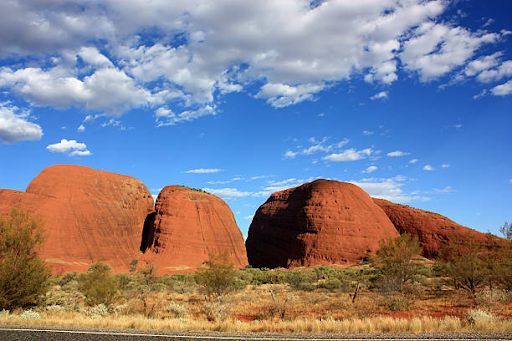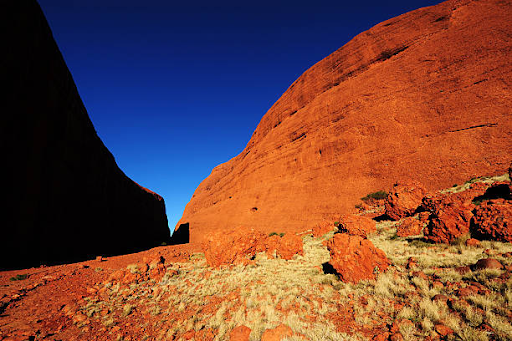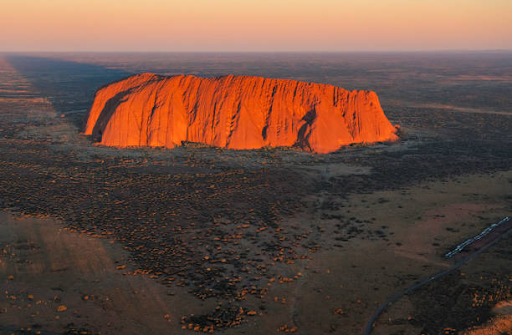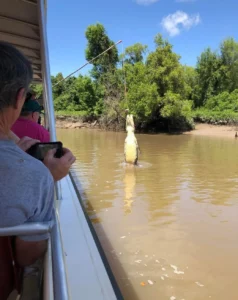
Uluru, also known as Ayers Rock, is a massive sandstone monolith that rises dramatically from the central Australian desert in the Northern Territory. Situated in the Uluru-Kata Tjuta National Park, this iconic formation is not only a spectacular natural wonder but also a place of deep spiritual significance to the indigenous Anangu people. Recognized as a UNESCO World Heritage Site, Uluru has long attracted visitors from around the world, beckoning them to discover its ancient mysteries and arresting beauty. In this article, we’ll explore the location of Uluru, delve into its cultural history, and provide everything you need to know to plan your visit to this extraordinary Australian landmark.
Unveiling Uluru’s Location: The Heart of the Red Centre
Uluru stands in the southern part of the Northern Territory, roughly 450 kilometers southwest of Alice Springs, the closest major town. The rock itself is part of a larger desert region known as the Red Centre, named for the vivid red color of the soil and rock formations. This remote area can appear foreboding, yet it boasts a stark, captivating beauty that is unique to the Australian Outback. Visitors can appreciate the isolation of Uluru while also experiencing the deep connection to the land that the Anangu people have maintained for thousands of years.

For those looking to experience guided travel, alice springs to uluru tours offer a convenient way to explore the region with knowledgeable guides who can provide valuable insights into the unique geology, ecology, and Aboriginal culture that define this iconic Australian landscape.
Getting to Uluru: Travel Options and Tips
Travelers have several options to reach Uluru, each offering a different perspective on the vast Australian Outback. The nearest commercial airport is located in the town of Yulara, a short drive from Uluru itself. From major cities like Sydney and Melbourne, you can catch direct flights to the Ayers Rock Airport (Connellan Airport), making this one of the most convenient ways to arrive.
Those with an adventurous spirit might prefer the overland journey. Setting out from Alice Springs, you can take to the roads in a rented car or join one of the many alice springs to uluru tours that combine transportation with expert commentary. Here are a couple of options for those thinking of driving:
- Lasseter Highway: The direct route from Alice Springs to Uluru, tracing through the rugged desert terrain.
- Red Centre Way: A scenic loop that also includes Kings Canyon and other natural attractions within the region.
When planning a trip, travelers should consider the expansive nature of the Outback and prepare accordingly. Below is a short table of essentials to keep in mind:
| Item | Description |
|---|---|
| Water | Carry ample water to stay hydrated in the arid climate. |
| Navigation | Maps and GPS devices are crucial for navigating remote areas. |
| Sun Protection | Hat, sunglasses, and sunscreen to protect against the intense sun. |
| Emergency Supplies | First aid kit and emergency contact numbers. |
The Geography and Geology of Uluru
Uluru’s impressive form has been millions of years in the making. It’s composed of arkosic sandstone and rises 348 meters above the surrounding plain, measuring 9.4 kilometers in circumference. The rock is notable not only for its colossal size but also for its intriguing surface, which appears to change color at different times of the day, glowing red at dawn and sunset.
The monolith’s geology tells a tale that stretches back some 550 million years. Over time, the elements have sculpted its surface, creating crevasses, caves, and bizarre formations, many of which are tied to the Anangu’s Tjukurpa (cultural stories or law). This region is also a haven for unique wildlife, where species have adapted to the harsh climate, exhibiting remarkable resilience.
Visitors are encouraged to not only gaze upon Uluru but also to learn about the region’s formations, including these two not-to-miss features:
- The Mutitjulu Waterhole: A natural pool at the base of Uluru with historical significance and natural beauty.
- The Mala Walk: An interpretative walk along the base of Uluru that highlights ancient rock art and geological features.
Exploring the Surroundings: Kata Tjuta and the Uluru-Kata Tjuta National Park
While Uluru is the centerpiece, nearby Kata Tjuta (also known as the Olgas) deserves equal attention. This group of large, ancient rock domes is located about 40 kilometers to the west of Uluru and presents a strikingly different landscape. Kata Tjuta is deeply sacred to the Anangu people, with its own unique stories and spiritual significance.
The Uluru-Kata Tjuta National Park encompasses both Uluru and Kata Tjuta and is a must-visit for any traveler to the area. The park offers a range of walking trails, cultural experiences, and viewpoints. Whether you’re marveling at sunrise from the Talinguru Nyakunytjaku viewing area or taking in the contrasting colors of the Valley of the Winds walk at Kata Tjuta, there’s no shortage of awe-inspiring experiences.
Cultural Significance and Visitor Etiquette at Uluru
Uluru is more than a physical landmark; it’s a cultural tapestry woven with the stories and traditions of the Anangu people. For them, it is a living cultural landscape that contains the spirits of their ancestors. Many Anangu traditions, rituals, and laws are connected to Uluru, and so visitors are asked to approach the site with respect and mindfulness.

As a mark of respect, it is crucial that visitors do not climb Uluru. This practice was officially discontinued in 2019, which aligns visitors’ experiences with the cultural expectations of the Anangu. Furthermore, there are designated areas for photography, as some areas of Uluru and Kata Tjuta are considered too sacred to capture on film.
Preservation Efforts and Sustainable Tourism at Uluru
The delicate ecology and cultural sanctity of Uluru call for careful preservation strategies. Park management operates in close collaboration with the Anangu people to ensure that tourism activities are sustainable and that the integrity of the site is maintained for future generations.
Visitors play a vital role in these efforts by adhering to established paths, foregoing climbing, and leaving no trace of their presence. In doing so, they help safeguard the natural environment and uphold the cultural values that make Uluru a place of global significance.
Conclusion: Uluru’s Timeless Allure and Ongoing Legacy
Uluru’s allure stems from its enigmatic beauty, deep cultural roots, and rugged Outback setting. This remarkable natural wonder inspires a sense of reverence and connection, inviting visitors to delve deeper into Australia’s ancient heritage. As we continue to value and protect Uluru, we not only honor the traditions of the Anangu people but also share in the stewardship of one of the world’s most precious geological and cultural treasures.
FAQs About Uluru
Q1: Can you climb Uluru?
A1: As of October 26, 2019, climbing Uluru is officially prohibited, out of respect for the Anangu people’s cultural beliefs, as well as environmental and safety concerns.
Q2: When is the best time to visit Uluru?
A2: The best time to visit Uluru is during the cooler months from May to September when the weather is more temperate, allowing for a more comfortable exploration of the area.
Q3: Is there accommodation near Uluru?
A3: Yes, there are various accommodations ranging from camping sites and lodges to luxury hotels at the nearby Ayers Rock Resort, also known as Yulara.
Q4: Are there guided tours available at Uluru?
A4: Yes, there are several guided tours available that offer insight into the cultural significance of Uluru, its geology, and surrounding ecosystems. These tours are offered by various operators and can be booked in advance.
Q5: What should visitors bring when exploring Uluru?
A5: Visitors should bring water, sun protection (hat, sunglasses, and sunscreen), comfortable walking shoes, and weather-appropriate clothing. Additionally, a camera for photos and a sense of respect for the cultural site are essential.

